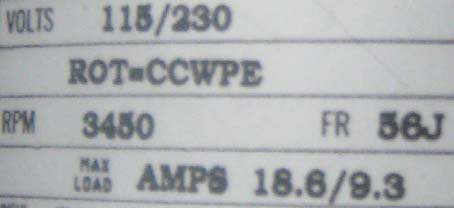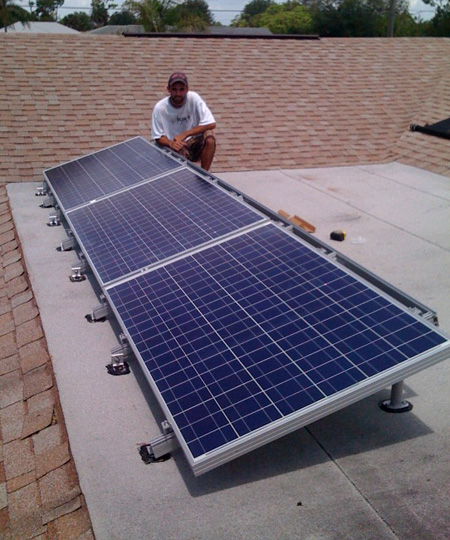SunRay Pool Pumps
FAQ's and Facts
FAQ's and Facts
How much electricity is your pool pump using?
A basic electrical calculation using “Ohm’s Law” requires obtaining the voltage and amperage of a device. Ohm’s law states that if you know the volts and amps of a device, you can then calculate the Watts. Located on the pool motor is the rating plate. Note that there will be two units of information required: 1) the voltage and 2) the amperage (see example below).
Often times the motor will state two voltages and like wise two amperages. In regards to the calculation sheet prepared for the Homeowner, this will have no effect on the outcome of the calculation. However, it is noteworthy that the voltage will typically be stated as 115/230 and the amps will likewise state two amperages. In the example below, the amperages are 18.6/9.3. When the motor is wired for 115 volts the higher or first number is used, and when wired for 230 volts, the lower amperage will be used. Most pool systems are wired to run on 230 volts. Below is an example of a 1.5 horsepower motor specification and the calculation to show how to determine the kilowatt-hour consumption.

What does it cost for your pool pump to operate?
Example:
- Pool motor volts X amps = Watts .....................230 v X 9.3 a =2139 Watts
- Divide by 1000 = kWh .....................................2139 W / 1000 =2.139 kWh
- Multiply by hours of day (run time) ..................2.139 X 8 hours = 17.11 kWh daily
- Multiply by number days in billing cycle............17.11 X 30.4 days= 524.2 kWh per month
- Multiply by cost of KWH = monthly savings.......524.2 X .13 = $68.15 Monthly Savings
- Multiply monthly savings by 12 = Annual Savings....$68.15 X 12 = $817.75 Per Year
How to calculate your pool pump electrical consumption:
_________ X _______ = _______Watts
(Volts)..........X.. (Amps)
_________ / 1000 = __________kW
(Watts)
_________ X ___________ = __________kWh/Day
(kW)............X...... (Hrs/Day)
_________ X 30.4 days = _________ kWh/Month
(kWh/day)
____________ X $0.13 = $_________ Monthly Cost
(Monthly kWh)
$____________ X 12 = $_________ Annual Cost
(Monthly Cost)
What size solar pool pump should you get?
Proper filtration of the pool in the sun requires the water to pass thru the filter at least once per day or within two days; this is also referred to as “turning the water over”. SunRay offers six solar powered pool pump systems, thereby allowing us to filter from the smallest of pools up to 100,000 gallons with a single system. Pump systems can be plumbed together to filter even larger pools.
SunRay Systems are not sized by horsepower, rather volume of water to filter. One of the many great aspects of the system is that all systems utilize the same pump, motor and controller assembly. The more energy delivered to the controller the higher the revolutions and the greater the flow rate. The six systems are based on the amount of Watts delivered to the Motor Controller. However, depending on the pairing of the solar panels, the total Watts being delivered to the system is the actual size.
The SunRay Series Systems have all been certified by the Florida Solar Energy Center. Depending on the wattage of panels supplied with the system, the system will then have the nomenclature of the total wattage.
What is your annual return on investment (ROI)?
On average, the annual return on investment is 50 %.
The SunRay solar powered pool pump system explained
SunRay uses solar-electrical power to pump water. It is cost-effective for swimming pools, especially where utility rates (or daytime peak rates) are very high. A pool pump is one of the largest electrical loads in a home.
Algae require sunlight to grow and thus the greatest concern for algae growth is in the summer time. A solar pump is practical because the need for filtration is greatest during summer weather and the days are longer resulting in a longer run-time. In the winter, there is a lesser opportunity for algae growth and likewise, the days are shorter. Thus, the system works well with nature, naturally.
Additionally, the SunRay System works well with solar-thermal pool heaters as the flow rate corresponds with solar intensity. (Note the aforementioned statement about bubbles in pool.) Likewise, the SunRay System works well with all water treatment systems and automated vacuum systems.
SunRay Pumps are built with efficiency in mind. They use significantly less power than traditional AC pool pumps to produce the same pressure and flow. It just makes sense to let the sun power your pool pump instead of you paying the electric bill for it.
How much pollution does your pool pump generate?
________________ X 1.9lbs = _________________ X 12 months= _______________
(Monthly kWh)...........X........... (Lbs. per month).................................= (Lbs. per year)
How much will your property value increase?
$_______________ X 20 = $____________________________
(Annual Savings)......X.20 .........(Added Value Increase)
According to the Appraisal Journal - home value increases by $20 for every $1 dollar savings in annual energy costs.
What type of filters should you use with the SunRay solar pool pump system?
Cartridge type filters are preferred with the solar powered pool pumps. The System also works well with sand filters and DE filters. DE filters do not perform well with the variable speed water pumping
The following is noteworthy regarding DE filters:
- DE is NOT environmentally friendly.
- DE filters create the largest amount of back pressure on a system.
- DE requires back washing and there is a general trend to not allow the
water to be back-flushed into the yard or local waterways. - DE system requires the expensive rotary port valves that are prone to
malfunction. - No longer a need to purchase DE product.
- In general, replacing the DE filter with a cartridge type filter does not add much to the cost of the system and often times aids on the installation configuration.
Can you use the SunRay System with Solar Heating Panels?
Yes, Where solar-thermal panels are installed, at times, in low-light
conditions, the water returning to the pool, or flowing from the roof
may exceed the flow into the system, and bubbles may be visible in
the pool as a result of the vacuum break valve introducing air into the
system.
Does the SunRay system work with pool cleaning systems?
Manual vacuuming and the “pop-up” type pool cleaning systems
require sunlight when performing this operation and the
sun may not cooperate.
What are photovoltaic modules (solar modules)?
Solar energy begins with the sun. Solar Modules, also known as photovoltaic panels, are used to convert light from the sun, which is composed of particles of energy called "photons", into electricity that can be used to power electrical loads. Light from the sun is a renewable energy resource which provides clean energy, produced by solar panels.
Solar modules can be used for a wide variety of applications including remote power systems for cabins, telecommunications equipment, remote sensing, and of course for the production of electricity by residential and commercial solar panel systems.
The development of solar energy goes back more than 100 years. In the early days, solar power was used primarily for the production of steam which could be used to drive machinery. But it wasn't until the discovery of the "photovoltaic effect" by Henri Becquerel that would allow the conversion of sunlight solar electric energy. Becquerel's discovery then led to the invention in 1893 by Charles Fritts of the first genuine solar cell which was formed by coating sheets of selenium with a thin layer of gold. And from this humble beginning would arise the device we know today as the solar panel.
Russel Ohl, an American inventor on the payroll of Bell Laboratories, patented the world's first silicon solar cell in 1941. Ohl's invention led to the production of the first solar panel in 1954 by the same company. The new-fangled solar electric panels found their first mainstream use in space satellites. For most people, the first solar electric panel in their life was probably embedded in their new calculator - circa the 1970s! Today, solar modules and complete solar panel systems are used to power a wide variety of applications. Yes, solar modules in the form of solar cells are still being used in calculators. However, they are also being used to provide solar power to entire homes and commercial buildings, such as Google's headquarters in California.
How do solar modules work?
Solar modules collect clean renewable energy in the form of sunlight and convert that light into electricity which can then be used to provide power for electrical loads. Solar modules are comprised of several individual solar cells which are themselves composed of layers of silicon, phosphorous (which provides the negative charge), and boron (which provides the positive charge). Solar modules absorb the photons and in doing so initiate an electric current. The resulting energy generated from photons striking the surface of the solar panel allows electrons to be knocked out of their atomic orbits and released into the electric field generated by the solar cells which then pull these free electrons into a directional current. This entire process is known as the Photovoltaic Effect.
Where should you place the solar array?
The solar array is best positioned facing south or west but, in general, can be placed anywhere except facing north. (Special mounting may facilitate mounting with a northern exposure.) Make sure that there will be no shadows blocking the solar array during peak run times. Determining the location of the solar panels will then determine the length of electrical wire and thusly, the appropriate size of the electrical wire and the effect on the installation cost.

Can you still use your Water Treatment System?
Most water treatment systems can be permanently connected to an AC power source. They will operate properly using their built-in flow sensor.